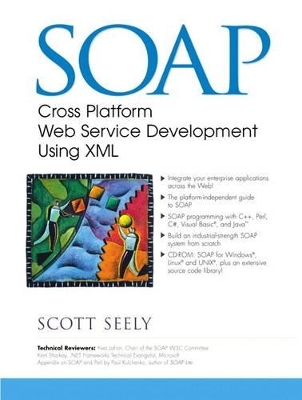
SOAP
Prentice Hall
978-0-13-090763-9 (ISBN)
- Titel ist leider vergriffen;
keine Neuauflage - Artikel merken
SOAP will be the universal "application glue" for tomorrow's widely distributed systems. It's simple, based on widely deployed standards such as XML and HTTP, and will enable virtually any business software to communicate across the Internet. SOAP: Cross Platform Internet Development Using XML offers a practical, hands-on introduction to SOAP that demonstrates how to leverage this technology on multiple platforms, using virtually every leading programming language. Seely begins by reviewing the history of distributed computing, and demonstrating how SOAP solves distributed computing problems that DCOM and CORBA failed to solve. He presents basic introductions to XML, and then to SOAP's syntax -- including SOAP's use of HTTP headers, the SOAP payload, error handling, data types, encoding structures, and more. You'll walk through building a simple SOAP server for Windows; then discover how SOAP can be extended to support multiple platforms and programming languages. SOAP: Cross Platform Internet Development Using XML contains detailed chapters on utilizing SOAP with each of five leading programming languages: C++, Perl, Python, Visual Basic, and Java.
The book concludes by reviewing today's leading SOAP servers. For all developers and system integrators constructing Internet applications, applications written in multiple programming languages, or applications that integrate diverse enterprise systems; and for any IT professional evaluating SOAP.
SCOTT SEELY has written extensively on Windows and UNIX/Linux programming, as well as on C, C++, and Visual C++, and he has recently joined Microsoft. He is author of Windows Shell Programming (Prentice Hall PTR).
Foreword.
Acknowledgments.
I. SOAP-EVERYTHING YOU WANT TO KNOW.
1. How We Got to SOAP.
The Abacus. Early Calculators. Programmable Machines. Electronic Computers. Distributed Computing. Summary. Bibliography.
2. XML Overview.
Uniform Resource Indentifiers. XML Basics. XML Schemas. XML Namespaces. XML Attributes. Summary.
3. The Soap Specification.
Things to Know. Rules for Encoding Types in XML. The SOAP Message Exchange Model. Structure of a SOAP Message. Using SOAP in HTTP. Using SOAP for RPC. Summary.
4. Building a Basic SOAP Client and Server.
SOAP Library Design. In Search of One Good Socket Library. SimpleSOAP Library. SOAPNetwork Library. A Simple SOAP Server. A Simple SOAP Client. Summary. Fun Things to Try.
II. RELATED TECHNOLOGIES.
5. Web Services Description Language.
WSDL Overview. Defining a Web Service. SOAP Binding. HTTP GET and POST Binding. MIME Binding. Summary.
6. Universal Description, Discovery, and Integration.
UDDI Basics. Where Does UDDI Fit In? UDDI Information Types. The Programmer's API. Summary.
7. Available SOAP Implementations.
Apache. IdooXoap. Iona. Microsoft. pocketSOAP. RogueWave. SOAP::Lite. White Mesa. Zope. Summary.
III. CASE STUDY: A WEB-BASED ACUTION SYSTEM.
8. Auction System and Requirements.
Background. Executive Summary. Bidder Enrollment and Management. Item Enrollment and Management. The Bidding System. Reporting. Summary.
9. Auction System Design.
Bidder Enrollment and Management. Item Enrollment and Management. The Bidding System. Summary.
10. Bidder Enrollment.
The Java Environment. Setting Up the Java Enviroment. Securing Access to the Web Service. The VB Environment. Summary.
11. Category and Item Management.
General Implementation Rules. Category Management. Item Management. Summary.
12. The Bidding System.
Bidding Pages. Bidding Web Service. Summary.
13. Case Study Summary.
Client Management. Category Management. Item Management. Auction. Summary.
Appendix.
Index.
| Erscheint lt. Verlag | 31.8.2001 |
|---|---|
| Verlagsort | Upper Saddle River |
| Sprache | englisch |
| Maße | 177 x 235 mm |
| Gewicht | 805 g |
| Themenwelt | Informatik ► Software Entwicklung ► Objektorientierung |
| Mathematik / Informatik ► Informatik ► Web / Internet | |
| ISBN-10 | 0-13-090763-4 / 0130907634 |
| ISBN-13 | 978-0-13-090763-9 / 9780130907639 |
| Zustand | Neuware |
| Haben Sie eine Frage zum Produkt? |